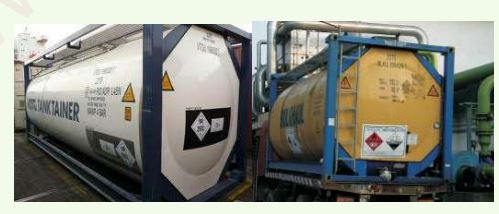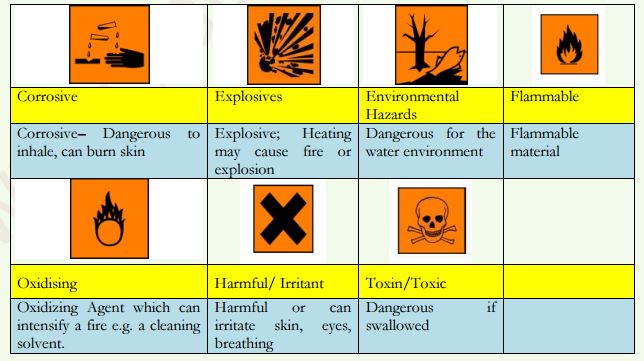Labeling and Packaging of Hazardous Materials
Abbreviations & Glossary
CAS: Chemical Abstract Service
[CAS numbers are used to provide a unique, unmistakable identifier for chemical substances and provide an unambiguous way to identify a chemical substance A CAS No. is separated by hyphens into three parts-the first consisting from two to seven digits, the second consisting of two digits, and the third consisting of a single digit serving as a check digit].
CBEC: Central Board of Excise and Customs
CCR: Compulsory Compliance Requirement
DGFT: Director General of Foreign Trade
DIPP: Department of Industrial Policy and Promotion
EIP: Emergency Information Panel
FT (D &R) Act: Foreign Trade (Development & Regulation) Act, 1992
GHS: Globally Harmonized system of classification and labeling of Chemicals
HS Code: Harmonized Commodity Description and Coding System
[It is an internationally standardized system of names and numbers for classifying traded products. It has been developed and maintained by the WCO. It is based on HS Convention.]
IAEA: International Atomic Energy Agency
ICAO: International Civil Aviation Organization
IED: Improvised Explosive Devices
IMDG: International Maritime Dangerous Goods.
IMO: International Maritime Organization
ITC (HS): Indian Trade Classification based on Harmonised System
IUPAC: International Union of Pure and Applied Chemistry Labeling and Packaging of Hazardous Materials
ISO: International Organization for Standardization
MSDS: Material Safety Data Sheet (MSDS)
[It is documents provided by the manufacturer that contain information on physical and chemical properties of material, potential hazards of the material, and how to work safely with hazardous substances. They also contain information on the use, storage, handling, and emergency procedures related to hazards of the material. All MSDSs contain eight (8) sections, but most of them contain additional sections]
NEPA: National Fire Protection Administration
NISG: National Institute of Smart Governance
PESO: Petroleum and Explosive Safety Organisation.
[It is a department of the Government of India entrusted with responsibility of controlling and administering usage of explosives in India. It is headed by the Chief Controller of explosives and is headquartered at Nagpur].
PGS: Programme Global Shield (WCO Programme for prevention of smuggling and diversion of Precursor Chemicals, commonly used for manufacture of IEDs)
SDS: Safety Data Sheet
TOST: Target Organ Systemic Toxicity
UN Code: United Nation Number
[UN numbers, or UN IDs, are four-digit numbers that identify hazardous substances and articles (such as explosives, flammable liquids, toxic substances, etc.].
UNCETDG: United Nations Committee of Experts on the Transport of Dangerous Goods
UNESC: UN Economic and Social Commission
WCO: World Custom Organisation
1. Introduction
1.1 All precursor Chemicals for IEDs (except Urea and Calcium Ammonium Nitrate) are considered to be hazardous chemicals. In the United Nations, all work related to Hazardous Material is dealt by the Committee of Experts under the UN Economic and Social Council (ECOSOC). Under the Committee of Experts, following two subcommittees have been constituted:
(i) Transport of dangerous Goods (TDG Sub-Committee) [Recommendations of the Committee published in the form of “Orange Book”].
(ii) Globally Harmonized System of Classification and Labeling of Chemicals (GHS Sub-Committee) [Recommendations of the Committee published in the form of “Purple Book”.]
1.2 The both sub-committees i.e. UNCEGHS and UNECTDG, operate under the parent Committee entrusted with specific responsibility for the above mentioned two areas. In case of radio-active material, the International Atomic Energy Agency (IAEA) has produced the Regulations for the Safe Transport of Radioactive Material.
1.3 The Recommendations by the Committee of experts on the Transport of Dangerous Goods inter alia consists of MODEL regulation and UN List of Dangerous goods (UN Numbers), most commonly carried and their identification and classification;). These recommendations also cover the following areas:
(i) Consignment procedures: labelling, marking, and transport documents;
(ii) Standards for packaging, test procedures, and certification;
(iii) Standards for multimodal tank-containers, test procedures and certification.
1.4 The Recommendations on the Transport of Dangerous Goods and the IAEA Regulations for the Safe Transport of Radioactive Material provides guidelines to all Governments for the development of their national requirements for the domestic transport of dangerous goods. These recommendations are also used by the international organizations such as (i) the International Maritime Organization (IMO); (ii) the International Civil Aviation Organization (ICAO) and (iii) regional commissions such as the Economic Commission for Europe for regulations and international/regional agreements or conventions governing the international transport of dangerous goods by sea, air, road, rail and inland waterways.
1.5 Now a day, with industrial growth and increasing use of chemical in day-to-day life, the volume of chemicals including hazardous chemicals being transported have increased considerably. During transport, the chemicals are subjected to vibration, shock, compression, impact, exposure to heat and water, increasing chances of leakage or accident involving hazardous chemicals, thus endangering life, property and environment. Therefore, transport of dangerous goods is required to be regulated so as to prevent loss or life, property and damage to the environment.
1.6 While transportation of dangerous goods is subject to national and international control, the dangerous goods are also subject to other kinds of controls /regulations, e.g. work safety regulations, consumer protection regulations, storage regulations, environment protection regulations. Each country has different ways to control various aspects of dangerous goods in a non-harmonized ways. Different approach by different countries affected international trade in chemicals and dangerous products.
1.7 To ensure consistency between all these regulatory systems, the United Nations has developed mechanisms for the harmonization of hazard classification criteria and hazard communication tools (GHS) as well as for transport conditions for all modes for transport (TDG).
[1.8In 2003, the United Nations (UN) adopted the Globally Harmonized System of Classification and Labelling of Chemicals (GHS). The GHS includes the following elements:
(i) Harmonised criteria for classifying substances and mixtures according to their health, environment and Physical hazards; and
(ii) Harmonised hazard communication elements, including requirements for labeling and safety data sheets (SDS).
Note: For knowing about SDS or MSDS, e-books on Material Safety Data Sheet may be referred.
1.9 As per GHS documents, the objectives of the Harmonization are as under:
(i) to enhance the protection of human health and environment by providing an internationally comprehensible system for HAZARD COMMUNICATION
(ii) to provide recognized framework for those countries without an existing system;
(iii) to reduce the need for testing and evaluation of chemicals
(iv) to facilitate international trade in chemicals whose hazards have been property assessed and identified on international basis.
1.10 The GHS covers all hazardous chemicals. Target audiences for the GHS include consumers, workers, transport workers, and emergency responders. The goal of GHS is to identify the intrinsic hazards found in substance and mixtures and to convey hazard information about these Hazards to all stake holders. The criteria for hazard classification are harmonized. Hazard statement, symbols and signal words have been standardized and harmonized and now form an integrated hazard communication system.
1.11 The pictograms used at work place provide basic hazard information. The following pictograms are used at Work Place:
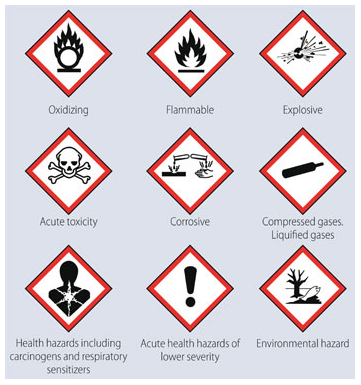
2. Labelling and Packaging
2.1 The term “Label” indicate an appropriate group of written, printed or graphic information elements concerning a hazardous product, selected as relevant to the target sector (s), that is affixed to, printed on, or attached to the immediate container of the hazardous product, or to the outside packaging of a hazardous product. Any label consists of following elements:-
(i) Symbols (pictogram)
Pictogram means a graphical composition that may include a symbol plus other graphic elements, such as a border, background pattern or colour that is intended to convey specific information.
(ii) Signal word.
- The signal word indicates the relative degree of severity a hazard.
- The signal words used in the GHS are “Danger” for the more severe hazards, and “Warning” for the less severe hazards.
- Signal words are standardized.
- Only one signal word corresponding to the class of the most severe hazard is used on a label in cases of chemical posing several hazards.
(iii) Hazard Statement
Hazard statements has been standardized and assigned phrases that describe the hazard(s) as determined by hazard classification. An appropriate statement for each GHS hazard is included on the label for products possessing more than one hazard.
(iv) Precautionary Statement
Precautionary statement means a phrase (and/or pictogram) that describes recommended measures that should be taken to minimize or prevent adverse effects resulting from exposure to a hazardous product, or improper storage or handling of a hazardous product.
(v) Product Identifier
A product identifier used on a GHS label, is similar to one used on the Safety Data Sheet. Where a substance or mixture is covered by the UN Model Regulations on the Transport of Dangerous Goods, the UN proper shipping name should also be used on the package.
The GHS label for a substance includes the chemical identity of the substance (name as determined by IUPAC, ISO, CAS or technical name). For mixtures/alloys, the label include the chemical identities of all ingredients that contribute to acute toxicity, skin corrosion or serious eye damage, germ cell mutagenicity, carcinogenicity, reproductive toxicity, skin or respiratory sensitization, or Target Organ Systemic Toxicity (TOST), when these hazards appear on the label.
(vi) Supplier Identifier
It contains details such as the name, address and telephone number of the manufacturer or supplier of the product.
2.2 A Typical GHS label on a container containing Hazardous chemical may look like as given in picture below:
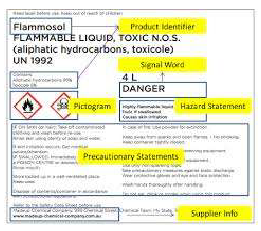
3. Placards and Safety Signs
3.1 Pictograms which are used in transport provide additional information, and are the same as those recommended by the UN for transport of Dangerous Goods.
3.2 The classification of Chemical hazards as recommended by the UN Committee of Experts on the Transport of Dangerous Goods has been widely adopted and used for transport of hazardous Chemicals for all modes of transport. Under this system Hazard types are segregated into nine basic classes represented numerically. Some of these classes are further separated into divisions and subdivisions according to appropriate criteria.
3.3 The classification of Chemical Hazards as well as Symbols indicating Hazards, as recommended by TDG Committee, have also been adopted by GHS Committee also. The pictograms, which communicate presence of hazards through pictures, are same under TDG as well as GHS committee. These pictograms are used at workplace, labels, packaging such as pails, barrels, drums, cardboard boxes, jerricanes, immediate bulk containers etc., as well as Transport containers etc. While on labels, pictograms are of smaller size, on bulk containers, pictograms are of bigger size and contain more information.
3.4 The international classification system recommended by UNCETDG and also adopted by GHS Committee is given in Table-1 below.
Table-1
UN International Classification System
| Class | Division | Type of Hazard |
| Class 1: Explosives | Division 1.1 | Explosives with a mass explosion hazard |
| Division 1.2 | Explosives with a projection hazard | |
| Division 1.3 | Explosives with predominantly fire hazard | |
| Division 1.4 | Explosives with no significant blast hazard | |
| Division 1.5 | Very insensitive explosives | |
| Division 1.6 | Extremely insensitive explosive articles | |
| Class 2: Gases | Division 2.1 | Non Flammable Gases |
| Division 2.2 | Flammable Gases | |
| Division 2.3 | Poison Gases | |
| Class 3: Flammable Liquids | Division 3.1 | Flashpoint below – 18°C (0°F) |
| Division 3.2 | Flashpoint – 18°C and above but less than 23°C (73°F) | |
| Division 3.3 | Flashpoint of 23°C and up to 61°C (141°F) | |
| Class 4: Flammable Solids, Spontaneously Combustible Materials, and Materials that are Dangerous when wet. | Division 4.1 | Flammable Solids |
| Division 4.2 | Spontaneously combustible materials | |
| Division 4.3 | Material that are Dangerous when wet | |
| Class 5: Oxidizers and Organic Peroxides | Division 5.1 | Oxidisers |
| Division 5.2 | Organic Peroxides | |
| Class 6: Poisonous and Etiologic ( Infectious) Materials | Division 6.1 | Poisonous Materials |
| Division 6.2 | Harmful Substances | |
| Division 6.3 | Etiologic (Infectious) Materials | |
| Class 7: Radioactive Materials | ||
| Class 8: Corrosives | ||
| Class 9: Miscellaneous Hazardous Materials |
3.4 The pictogram, hazard-warning diamonds may also bear an approved inscription quoting the hazard and /or the United Nations hazard class number. The basic principle however, is that the shape, colour and pictogram convey a clear message of danger. Pictograms overcome language difficulties and provide a warning to the general public to keep away. Further, in an accidental situation, the emergency services are provided information about the primary hazard likely to be encountered. In India, recommendations of the TDG committee of Experts have been incorporated in the Motor Vehicle Rules, 1989.
Placards and Safety Signs
3.5 Placards provide a visual clue that something hazardous is being transported or stored. Under UN Placard System, Diamond-shaped placards, not less than 250 mm by 250 mm on each, required to be used. Further, placards must appear on all four sides of the vehicle.
| Labels/Transport Pictogram | ||
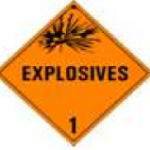 |  | |
| Symbol: Exploding Bomb [for Division 1.1 to 1.3] | Symbol: Only Number | |
| Colour of Symbol: Black | Colour of Symbol: Black | |
| Background : Orange | Background: Orange | |
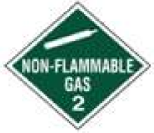 | 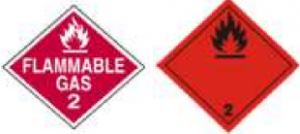 | 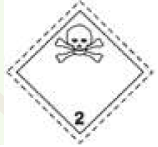 |
| Symbol: Gas cylinder: | Symbol: Flame: | Symbol: Skull and Cross Bones: |
| Colour of Symbol: Black or White | Colour of Symbol: Black or White | Colour of Symbol: Black |
| Background: Green | Background: Red | Background: White |
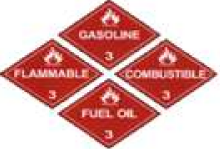 | 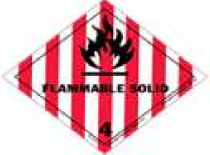 | 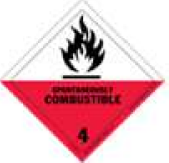 |
| Symbol: Flame | Symbol: Flame | Symbol: Flame |
| Symbol Colour: Black or White | Symbol Colour: Black | Symbol Colour:Black |
| Background: Red | Background: White with vertical red stripes | Background: Upper half White and lower half Red |
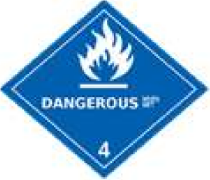 |  |  |
| Symbol: Flame | Symbol: Flame over circle | Symbol: Flame over circle |
| Symbol Colour: Black or White | Symbol Colour : Black | Symbol Colour : Black |
| Background : Blue | Background : Yellow | Background : Yellow |
 |  |  |
| Symbol: Skull and crossbones | Symbol: St. Andrew’s cross over an ear of wheat.The bottom half of the label should bear the inscription: HARMFUL stow away from food-stuffs.
| Symbol: three crescents superimposed on a circle.Inscription :The bottom half of the label should bear: INFECTIOUS SUBSTANCES (optional) and the inscription “In the case of damage or leakage immediately notify Public Health Authority” (optional) |
| Symbol Colour : Black | Symbol Colour : Black | Symbol Colour : Black |
| Background : White | Background : White | Background : White |
 |  |  |
| Symbol: 3 segments of acircle a number. Symbol Colour: Black Background: Upper Half Yellow and Lower Half White | Symbol: liquids spilling from two glass vessels and attacking a hand and metalBackground: Upper half White and lower half Black with White border. Symbol colour: Black | Background: White Upper half with Black Stripe. |
3.6 A Typical TDG Placard on a transport bulk container carrying dangerous goods may look like as given in picture below:
3.7 Dangerous Goods shipping labels are smaller versions of the placards. Shipping labels are designed for smaller shipments, e.g. boxes, barrels, canes etc.
3.8 Some other Types of Shipping Labels (European System), which may be found on hazardous goods, are as given in Table 3 below:-.
Table 3
4. NFPA 704: Standard System for the Identification of the Hazards of Materials for Emergency Response
4.1 NFPA 704 is a standard maintained by the National Fire Protection Association of USA. It defines the colloquial “fire diamond” used by emergency personnel to quickly and easily identify the risks posed by hazardous materials. This helps determine what, if any, special equipment should be used, procedures followed, or precautions taken during the initial stages of an emergency response.
4.2 In 4-Colour Diamond system of communication of Hazards, the four divisions are typically color-coded with red indicating flammability, blue indicating level of health hazard, yellow for chemical reactivity, and white containing codes for special hazards. Each of health, flammability and reactivity is rated on a scale from 0 (no hazard) to 4 (severe risk).
4.3 Instability/Reactivity
| 4 | May detonate |
| 3 | Shock and heat may detonate |
| 2 | Violent chemical change |
| 1 | Unstable if heated |
| 0 | Stable |
4.4 Fire Hazard:
| 4 | Below 73 F |
| 3 | Flash Point below 100 F |
| 2 | Flash point below 200 F |
| 1 | Flash point above 200F |
| 0 | Will not burn |
4.5 Health Hazard
| 4 | Deadly |
| 3 | Extreme danger |
| 2 | Hazardous |
| 1 | Slightly hazardous |
| 0 | Normal material |
4.6 Specific Hazard: White Background
| OXY | Oxidizer |
| ACID | Acid |
| ALK | Alkali |
| COR | Corrosive |
| W | Use NO WATER |
| Radiation Hazard |
4.7 These Fire Diamond in sign form are found on the outside doors or walls and the inside of many facilities that use chemicals in their daily processes. As per NFPA, signs be located in the following locations: (1) Two exterior walls or enclosures containing a means of access to a building or facility; (2) Each access to a room or area; (3) Each principal means of access to an exterior storage area. Access, configuration, size, location and construction of the building will factor in the location and number of signs required.
4.8 A Typical Fire Diamond may look like as given in picture below:
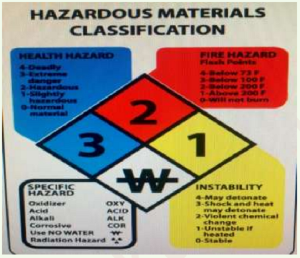
5. Legislative Provisions at a Glance to implement GHS and TDG Committees Recommendations
5.1 In India, legislative provisions government transport of dangerous goods are contained in the Explosive Rules, 2008 (in respect of explosive), and Central Motor Vehicle Rules, 1989.
| Sr. No. | Act/Rules/Notification | Subject |
| 1. | Recommendations of the UNCETDG contained in Orange Book | The recommendations include model legislation and UN Code for goods considered to be dangerous for Transportation. In India, the recommendations given by UNCETDG have been incorporated in the Explosive Rules, 2008 as well as Central Motor Vehicles Rules, 1989. |
| 2. | Central Motor Vehicles Rules, 1989 | Rule 9: Educational qualifications for drivers of goods carriages carrying dangerous or hazardous goodsRule 90: Additional conditions for national permitRule 129. Transportation of goods of dangerous or hazardous nature to human lifeRule 131: Responsibility of the consignor for safe transport of dangerous or hazardous goodsRule 132: Responsibility of the transporter or owner of goods carriageRule 133. Responsibility of the driver Rule 134. Emergency information panel Rule 135. Driver to be instructedRule 136. Driver to report to the police station about accident Rule 137. Class labels |
| 3. | Explosive Rules, 2008 | Recommendations of UN Committee on Transportation of dangerous goods as far as they relate to explosives have been incorporated in the Explosive Rules, 2008 |
| 4. | Petroleum Rules, 2002 | These rules govern import, transportation or storage of petroleum. It also regulates refining, testing as well as accident reporting etc. |
| 5. | Draft The Hazardous substances (Classification, packaging, and Labelling) Rules, 2011 | These rules have been framed considering GHS System. However, these are draft rules and final rules are yet to be notified. |
| 6. | Manufacture, Storage and Import of Hazardous Chemical Rules, 1989 as amended | These rules provides legal framework for manufacture, storage and Import of Hazardous Chemicals in India. These rules have been issued under Environment (Protection) Act, 1986. |
| 7. | The Factories Act, 1948 | The Factories Act, 1948 has been amended to incorporate provisions to ensure safety and health of the workers. Further, the Model Factories Rules have also framed for the manufacturing sector, which can be adopted by the State Government. |
| 8. | The Chemical Accidents(Emergency, Planning, Preparedness and Response) Rules 1986,Ministry of Environment, Forest and Climate Change | These Rules prescribes various safety and environment standards for chemical plants. |
Source-National Academy of Customs Excise and Narcotics Regional Training Institute, Kanpur (India)
